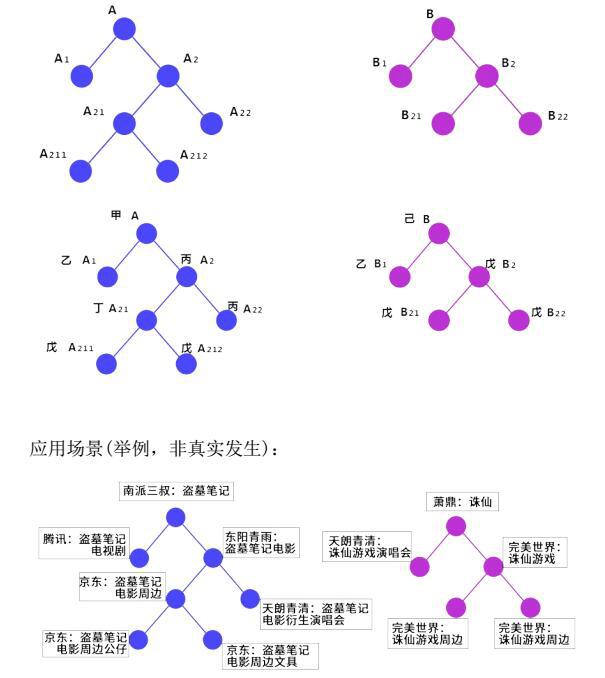-
Cryptocurrencies
-
Exchanges
-
Media
All languages
Future Copyright is an intelligent trading platform for cultural and entertainment copyright based on blockchain technology managed by Singapore UIP Foundation. Future Copyright is committed to providing global cultural and entertainment IP copyright holders with one-stop cultural and entertainment copyright intelligent services such as copyright deposit certificate, copyright transaction, NFT product incubation, and high-end encrypted art NFT transaction. In the future, copyright will help copyright holders create copyright digital asset NFT, trade copyright NFT, and maximize the value of copyright through asset certification, ownership marking, and digital scarcity brought about by blockchain technology.
Project Features
Business model of future copyright trading platform
The business logic of UIP can be defined as four layers as a whole, namely 1.IP digital copyright confirmation; 2.IP and IP derivative copyright transactions; 3.IP copyright rights and interests split; 4. IP rights sharing
1. Digital copyright confirmation
The original characteristics of blockchain technology, such as traceability and difficulty in tampering, will make the confirmation of digital assets very simple:
a. Users upload the digital files they want to deposit to the UIP system, and UIP will generate user blocks and calculate their hash values;
b. UIP records the root hash value of the user block Merkle Tree into the block of the anchor blockchain;
c. UIP broadcasts the root hash value of the anchor block Merkle Tree to the blockchain through transactions.
Through the above mechanism, UIP will reduce the cost of user certificate storage to the greatest extent, and at the same time ensure that the certificate data is broadcast to the public chain, so as to ensure that its certificate data is difficult to be tampered with by any individual or organization.

2. The traditional trading model of the future copyright trading platform
In the process of IP copyright asset trading, we provide traditional customers with the right to choose freely, that is, they can choose a centralized trading method and use traditional legal currency Asset transactions for the medium. At the same time, the future copyright trading platform will act as an intermediary, charge a certain service fee, and distribute part of the service fee through UIP token according to the proportion of UIP held by all users.
The advantage of this traditional model is that it can ensure that traditional customers can effectively avoid the transaction risks brought about by UIP price fluctuations, but at the same time it also loses the right to issue IPUnit on the future copyright trading platform.
We recommend forward-looking customers who accept future copyright forms to adopt a new de-intermediation UIP asset transaction model, which will be rolled out below.
3. Future copyright transaction platform copyright transaction and split economic model
3.1 Basic principles of creating an economic model
In the atomic world, the transaction of assets is the combination of the asset itself and the right to use in a credit intermediary Next, transfer occurs together. The emergence of blockchain has brought us into the era of quantum economy. Digital copyright is the digital asset of human beings. Its ownership and use rights can be separated, and its use rights can be infinitely subdivided. At the same time, under the distributed credit mechanism of blockchain, human beings can realize the disintermediation of transactions in the process of trading digital assets, thereby greatly reducing transaction costs. The characteristics of the free split and reorganization of digital assets in the quantum economy coincide exactly with the uncertainty and richness of future copyright forms.
However, under this model, the split and free trade of digital assets will cause confusion in the real world, such as disputes caused by partial overlapping rights after the split of copyright use rights. Therefore, smart contracts need to be introduced on top of the blockchain to establish the necessary consensus so that UIP's economic model can operate successfully in the real world.
3.2 De-intermediation transaction consensus model of future copyright trading platform
Transfer of IP usage rights: When there are more than one IPUnit holders of an IP, the IP usage rights will follow the following rules. All IPUnit holders People will abide by this rule by default, which appears in the contract signed by both parties online by default and is protected by the contract laws of various countries:
1. The initial right to use the digital asset will be owned by the creator who deposits the certificate first, that is, whoever deposits the certificate will own it;
2. Once the digital asset is confirmed, the digital asset of the uploader needs to be certified by the autonomous committee , to conduct transactions to prevent plagiarism and other situations;
3. When one party holds 51% of IPUnit, this party has the right to use and derive the IP; the derivative right is to ensure that the original IP generates derivative IP Rights arising from the right to use;
4. When a party enjoys the right to use IP, it can reduce the proportion of IPUnit it holds to below 51% with the consent of the original author, but at the same time it will lose the derivative right. Until any participant in the UIP market regains 51% of IPUnit, the party will obtain the right to use and derivative of this IP, and the original right to use the right holder will be automatically released one year from this moment;
5. In order to avoid the situation where the right to use is owned by multiple parties at the same time, IPUnit holders need to be cautious about their selling behavior and be responsible for the consequences. When multiple parties have the right to use IP at the same time, that is, when the IP ownership is exclusive but the use right is shared, the UIP platform thinks it is reasonable and has practical application scenarios;
6. Holding 51% of the total number of digital assets One party, will have the right to split the asset into sub-assets, but this right must be carried out under the following conditions:
a. The generation of a new asset must be converted from a part of the old asset, which represents the right to use the asset , still follow the 51% rule in this consensus;
b. When and only the holder holds 100% of the new assets, it can be destroyed, or restored to the parent chain, or a new chain can be generated; Before generating a new chain, it needs to be approved by the smart contract of the IP source author or after sending an application to it for approval before the new chain can be issued.
7. The fourth layer of trading platform assumptions:
When IP assets are continuously split and one day reaches a "shared mode" (any party's share of assets held does not exceed 51%), then Any party has the opportunity to use the asset (refer to the reality that the copyright usage rights of world masterpieces have been opened), and a certain proportion of IPUnit holders have the right to use it.
The era of IP exclusive sharing, that is, under the condition of ensuring the absolute ownership of IP by the original author, the right to use is opened to those who hold a certain proportion of IPUnit, which not only protects the rights of IP authors from being infringed, but also guarantees a certain It also greatly enriches the resources that IP can be combined, so that the original author of the IP, the IP itself, and its IP shareholders can fully enjoy the dividends of the IP sharing era brought by the blockchain.
In order to ensure the high-quality continuation of this IP, the demand side needs to apply for the use of the IP on the trading platform, which will be jointly reviewed by the IP source holder and the platform community self-government committee. The specific mechanism will be gradually improved during the construction process.
8. When an IP asset re-enters the 51% absolute use right situation from the shared situation (for example, the company holds this IPUnit from less than 51% to greater than or equal to 51% through continuous inhalation), then Other IP users determined by the autonomous committee before that still have the right to use the IP until the date stipulated in the smart contract.
Application scenario
Theoretically, the hierarchical derivation of IP can be continuously split into infinity, but in order to prevent unclear confirmation of rights, such as the sales conflict between derivatives of movie concerts and derivatives of original works, etc. The copyright split sale of the trading platform will still be broken down to the actual situation. Business scenario:

Project economy
1 Mode of operation
When a certain IP is initiated by the seller and generates IPUnit for the first time, a certain percentage of development fees will be charged; when IPUnit is traded through UIP token, a very small amount will be charged for each transaction transaction fee.
The value of UIP token: With the generation of a large number of IPUnits on the platform and the continuous increase of IPUnit transactions, the application scenarios and transaction value of UIP will continue to expand.
2 Industry Value Expectations of Copyright Trading Platforms in the Future
According to the 2015-2019 Global Entertainment and Media Industry Outlook released by PricewaterhouseCoopers on June 3, the revenue of the global entertainment and media industry will increase in the next five years. The average annual compound growth rate of 5.1% has been achieved in the past year, rising from 1.74 trillion US dollars (about 11.7 trillion yuan) in 2014 to 2.23 trillion US dollars (about 15.0 trillion yuan) in 2019.
If the transaction volume of the UIP trading platform can account for one-thousandth of the global entertainment and media industry revenue in 2019, then the total IP transaction volume of the trading platform will reach 14.99 billion yuan. According to the 3% trading platform transaction fee rate, the total platform transaction fee income is 450 million yuan.











